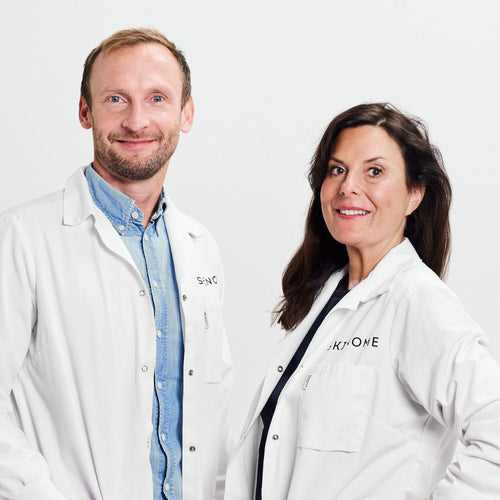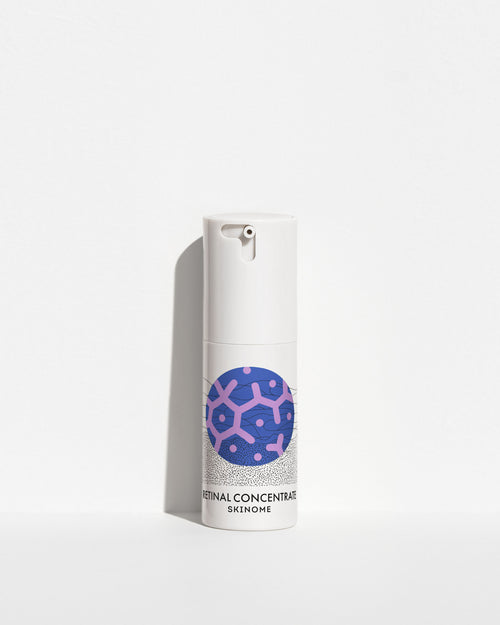Förstå din hudtyp
En bra start är att fundera över sin hudtyp – är huden normal, känslig, torr, oljig eller en kombination av dessa? Testa vad som stämmer bäst på just din hud och ta del av våra hudvårdstips:
Normal hud
Har du normal hud upplever du att huden känns spänstig och mjuk och du har inga uppenbara problem med torra eller feta områden i ansiktet. En viktig faktor är att huden inte känns, man har alltså ingen förnimmelse av den (huden svider, kliar eller stramar inte).
Tips: Har du normal hud har du inte heller några specifika besvär men kan vilja återfukta huden, speciellt här i Norden på grund av vårt torra och kalla klimat. Vår hud utsätts för både sol, låg luftfuktighet (speciellt på vintern), avgaser och temperatursväxlingar vilket bidrar till uttorkning och därmed ett ökat behov av fuktbindare i huden. Produkter som innehåller ingredienser som glycerin, salter , sockerarter, byggstenen till hyaluronsyra - N-acetyl glucosamine eller karbamid/Urea är effektiva på att binda fukt i huden vilket leder till aktiv återfuktning.
Vår hudflora bidrar också naturligt till fuktbindande ämnen i huden - stör den därför inte med överanvändning av hudvård eller rengöring (den vill nämligen inte bli störd och kommer tacka dig för hjälpen!). All yttre påverkan leder också till bildandet av fria radikaler som bland annat påverkar åldrandet av huden. Fria radikaler är något som antioxidanter är bra på att bryta ner, satsa på en produkt som innehåller på antioxidanter, som till exempel vitamin C och/eller mineraler som mangan. Leta också efter förpackningar med luftlösa pumpsystem som minskar kontakten med syre och därmed minskar risken för degradering hos antioxidanterna. En normal hud kan må bra av applikation av kalcium som bidrar till ökad cellförnyelse i epidermis.
Känslig hud
Många som upplever att de har känslig hud beskriver det som att huden kliar, bränner eller stinger och att man kan få starka reaktioner när huden kommer i kontakt med kosmetika, hudkrämer, tvål och även solljus. Har du känslig hud känner du förmodligen av en försämring under vintern när vi har ett kallt och torrt klimat.
Tips: Först och främst är det viktigt att du utreder vad om kan vara orsaken till att du har känslig hud, här kan du kanske behöva ta hjälp av en hudläkare. För dig med känslig hud är det nästan viktigare att veta vad du ska undvika än vad du ska tillföra huden. Vår hud är unik och reagerar individuellt och olika på vad den utsätts för. Det finns dock grupper av ämnen som du kan hålla utkik efter, även om många tål dem så finns det rapporter som visar att vissa ämnen orsakar känslighet eller irritation i huden oftare än andra.
Ämnen att undvika om man har känslig hud är alkohol, propylenglykol, eteriska oljor, parfym och vissa konserveringsmedel som methylisothiazolinone, fenoxietanol (phenoxyethanol) och bensoesyra (benzoyl alcohol) samt ethylhexyl glycerin. En ny forskningsrapport visar också att propylenglykol är det ämnet som stannar kvar längst på huden, i flera veckor efter applikation (Bouslimani et al., 2019). Var också försiktig med rengöringen av din hud – det räcker att använda en rengöringsprodukt på kvällen och endast skölja med ljummet vatten på morgonen.
En känslig hud kan även må bra av vissa anti-inflammatoriska substanser för att minska irritation och rödhet - exempel på dessa substanser är: Allantoin, Panthenol, Bisabolol, Naringenin, Acetyl Dipeptide 1 Cetyl ester. Hudkrämer mot känslig och röd hud (exempelvis rosaceadrabbad) innehåller också ofta grönt pigment för att dämpa rödheten kosmetiskt.
Torr hud
Du kan uppleva att huden kan strama, kännas lättirriterad och bli fnasig på vissa ställen. Det beror på att produktionen av vissa oljor och fuktbindare som normalt sker i huden inte fungerar som den ska och att vattnet därför avdunstar från huden.
Tips: Fuktbindande ämnen är viktiga att tillföra om du har torr hud, var också gärna försiktig med rengöringen och använd en mild rengöringskräm. En hudkräm för torr till normal hud kommer att innehålla mer fuktgivande och fuktbindande ämnen såsom glycerin, karbamid, olika sockerarter, salter eller aminosyror. Huden behöver även skyddas från vattenavdunstning (TEWL) och då krävs fett och olja som bildar ett lager som stänger inne fukten i huden.
Mineraloljor som paraffin och vaselin fungerar bra för att minska vattenavdunstningen i huden och är även snälla mot känslig hud. Däremot kommer dessa oljor från den petrokemiska industrin och är inte biologiskt nedbrytbara i naturen så för den miljömedvetne kan det vara bra att välja bort dessa. Silkoner fungerar också uppmjukande och är bra för känslig hud, de är dock heller inte biologiskt nedbrytbara. Alternativ på oljor, smör och vaxer som är mer biologiskt nedbrytbara och samtidigt minskar TEWL är vegetabiliska oljor, squalane, jojoba estrar eller exempelvis sheasmör.
I normalt tillstånd producerar vår hud både oljor och fetter helt på egen hand som till exempel squalen, ceramider, kolesterol, triglycerider och Omega 3/6-fettsyror. Dessa känner huden igen och produkter som innehåller dessa ämnen brukar fungera bra mot torr hud.












